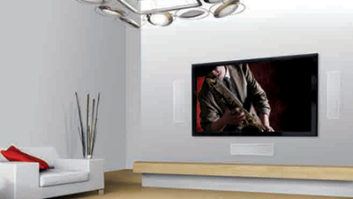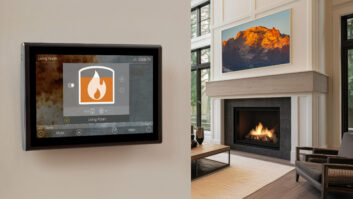Aesthetics and Performance Drive In-Wall Speaker Designs
Let’s face it. It’s been a tough year for small businesses. Some AV and systems manufacturers had as many as 40 of their dealers close their doors and experienced as much as a 40-percent drop in sales. That does not mean that manufacturers of bread-and-butter custom install products like in-wall speakers are going to throw in the towel. On the contrary, now is the time for

Monitor Audio made a name for itself with its creative use of metal alloys in driver cone technology, which are included in this C280LCR model. these companies to stand out from the crowd with new innovations.
“It has been a ‘fall-off’ year, that’s for sure,” offered ELAN Home Systems’ vice president of marketing, Cat Fowler. But after experiencing a significant sales uptick this March and an energized dealer base at ELAN’s nationwide Roadshow (www.roadshow09.com), Fowler is optimistic. “Our dealers are finding new opportunities,” she said, “and good dealers are thinking differently, changing their marketing a bit, looking for leads and going back to previous clients.”
ELAN has stepped in to strengthen client relationships with a new Upgrade Program. If a dealer reviews client records and sees upgrade potential, it’s Game On.
Fowler has another reason to be confident: the launch of 19 new in-wall and in-ceiling models in the ELAN Elios Line. The Elios speakers are now available (boasting clamping innovations, hybrid, nano-coated Teteron dome and pivoting tweeters) after a successful test run with 100 dealers.
And ELAN is not alone. Many manufacturers are rolling out in-wall and in-ceiling products this season to help their dealers reach new audiences. With the changing economic landscape, today’s AV systems client might be a middle-class family, a creative class professional in a downtown high-rise, or that mansion in the Hamptons.
LIQUID CLIENTS VS. SOLID INVESTMENTS
Custom dealers are looking for products that can add profit opportunities and resilience to their business. It’s not just about the next best thing, it’s more about selecting lines that sound fantastic and add recurring revenue streams.
The high-end luxury consumer may seem slightly cautious right now–it’s not the best time to be “liquid.” On the other hand, there are customers who want to re-invest in their homes by adding equity. Entertainment technology or room renovations are surprisingly popular right now.
Paradigm Electronics, a Canadian audio manufacturer,

Paradigm’s RVC-12SQ in-wall sub is designed for vibration cancellation and serious bass. has survived the year “quite well,” said Jack R. Shafton, director of sales and marketing at Paradigm. Their business is up a few percentages in this quarter, and in six to nine months, Paradigm “only lost a few dealers.” While some chain electronic stores are in trouble, Shafton sees custom specialists in the unique position to adapt and adjust to market needs. Residential dealers can also offer a value-added experience with much more resonance than Big Box Store commodity shopping (Circuit City…R.I.P.).
“People aren’t buying cars right now,” he observed, “so there are more resources to invest in the home. Customers are looking for high-value products that appeal to value consciousness…it’s more relevant in hard economic times.”
The New England manufacturer Russound is also promoting value with its new Acclaim speaker line. The higher-end Acclaim 7 and value-oriented Acclaim 5 are in-wall, in-ceiling, and LCR solutions for the range of room applications. The Acclaim 7 lineup includes “Iso-Mount” isolation system and a new seven-inch design for better bass, Twist and Tilt technology, and pivoting tweeters for personalized, directional output.
“HIGH” PERFORMANCE
Economics aside,

Genelec’s AIW25 active in-wall loudspeaker, the AIC25 Active in-ceiling loudspeaker (pictured) and the AOW312 Active on-wall loudspeaker the big trend for in-wall speakers for 2009, added Triad’s spokesman Paul Muto, is high-performance subwoofers built right into the ceiling. Triad Speakers has introduced two inceiling subwoofers, both with sealed and braced enclosures, long excursion drivers, and DSP amplifiers that make this practical. The Oregon manufacturer has released the in-ceiling Mini/8 Sub with an eight-inch driver in an enclosure 10.75 by 10.7 by 7.5 inches deep (compact to fit any ceiling). The InCeiling Bronze/10 sub with a 10-inch driver offers higher output and bass extension in a slightly larger package.
There are other developments in design and technology that help installers spec speakers into previously inaccessible ceiling spaces, with no compromise in quality. Motorization is key to SpeakerCraft’s Time Mini. The success of the original Time product has resulted in the development of three new smaller versions to fit more applications. The Time Mini 5.3 (aka the ASM76530) is a motorized in-ceiling speaker that stealthily descends when it’s turned on. It’s a 360- degree rotation with a 5.75-inch aluminum cone woofer 0.75-inch aluminum dome tweeter.
However, unlike the original Time speakers, the vertical angle is set at a fixed 45 degrees and the rotation of the drivers is done manually during installation and set-up by the installer.
“Time Mini delivers on the original promise of architectural speakers,” said Jeff Francisco, SpeakerCraft’s product development VP. “The solid flat surface that remains flush with the wall when it is fully retracted and not in use makes it a true invisible speaker.” To make the system disappear completely when not in use, the flat surface can be painted.
The British company Monitor Audio made a name for itself with its creative use of metal alloys in driver cone technology, and it is now shipping its Series 200-300 in-ceiling/in-wall theater speakers series. Alan Hook with Kevro International, distributor for Monitor, says that at the heart of the new in-ceiling and in-wall LCR models is a “unique inverted dual-concentric pivoting midrange/ tweeter module providing up to 18 degrees of play.” Speakers can be discreetly positioned, and then the sound can be directed into the desired listening zone by pivoting the IDC driver module to maximize performance. Hook hopes that the three-way designs offers better performance and flexibility over standard two-way or fixed-angle speaker designs.
For consumers desiring in-wall loudspeakers

TruAudio’s new Ghost Series’ speaker housing and frame disappear into the wall surface. all around the house, connecting speakers using NetStreams StreamNet IP technology makes a lot of practical sense, said Atlantic Technology’s Peter Tribeman. “A completely digital signal stream means better sound quality and perfect uniformity, so what’s not to like? IP offers advantages for audio distribution, and by bypassing the speaker’s analog crossover, there is a significant improvement in sound quality and a five dB gain in efficiency,” he explained.
Revel is known for its versatile loudspeakers and has extended its Concerta in-ceiling and inwall line, an affordable series of architectural loudspeakers. Leveraging the resources of its parent company Harman International Industries, the two new models are the IC6T2 6.5-inch in-ceiling model and the IW80 eight-inch, two-way in-wall loudspeaker. Both feature smart innards such as a low distortion woofer with a micro-ceramic composite cone and pivoting tweeter. Integral waveguide ensures consistent performance on- and off-axis and a boundary compensation switch for placement near secondary walls.
Nuanced acoustics and lifelike sound is also important to Florida manufacturer Niles Audio. The company’s IW770 FX is an enclosed “special effects” loudspeaker, featuring a direct seven-inch carbon-fiber

SpeakerCraft’s Time Mini 5.3 is a motorized in-ceiling speaker that descends when it’s turned on. woofer and one-inch Teteron tweeter. It includes dipole/bipole switching via a frontmounted switch or 12V rear-mounted trigger input and an “effects” level control that adjusts the relative level of direct radiating drivers to the special effects drivers.
HEARD BUT NOT SEEN
It’s clear that for the modern home the hot design trend isn’t just low-profile, it’s no profile. Remodels rarely include free-standing products.
Like its rival SpeakerCraft, California-based Sonance prioritizes invisible audio. Now shipping flat, totally discreet speakers that literally become a part of the wall. Sonance’s Invisible Series speakers vanish into the room design and deliver ambient music that emanates from the walls and ceilings.
The Sonance Invisible Series builds on flatpanel driver technology acquired from Sound Advance in 2005, with three new models, two of which utilize improved planar technology. The SA3 and SA1.5 combine unique, variable-thickness planar flat-panel midrange/tweeters with conventional, round dynamic woofers; the Invisible Series SAW is a subwoofer featuring conventional drivers. In all three models, the surface of the finished unit is covered with a completely flat, acoustically transparent vellum overlay that can be painted with a water-based finish, wallpapered, or covered with textured wall coverings without corrupting performance.
The flagship of Stealth Acoustics’ own invisible speakers line is the AX3, which is a three-way, fullrange speaker utilizing a rigid frame that fits into a standard 3.5-inch-deep stud wall. The paintable active diaphragm radiating surface is a structurally modified three-layer composite consisting of two layers of graphics-grade paper with a modified foam core, suitable for receiving most standard wall or ceiling finishes including latex paint, light texture, or wallpaper.
Another hard-to-see solution, TruAudio’s new Ghost Series is now shipping. As its name suggests, the new speaker’s housing and frame disappear into the surface once the wafer-thin magnetic grill is installed. It also boasts supremely simple installation to save dealers labor costs and time in the field.
And across the pond, the English company Amina Technologies has developed in-wall loudspeakers (such as the Sound Unseen line and AIW Plaster in-wall loudspeaker series) that are literally plastered in the wall. So whether they are covered with paint, wallpaper, or textured plaster, the speaker becomes invisible and withstands humidity and other solvents.
IN THE FIELD
In-wall speakers are excellent design choices, but there are drawbacks.

Sonance’s Invisible Series speakers vanish into the room design. Installation has to be coordinated. Wires must be run. Paint must be added. Innovations such as smoother clamping save time, but what about with hefty subwoofer enclosures? Shafton believes Paradigm’s RVC-12SQ in-wall sub solves a perennial issue for architectural subwoofers. With output levels on par with Paradigm Reference freestanding subwoofer designs, the RVC-12SQ provides vibration cancellation and serious bass performance from a nominal footprint (mountable in a standard two-by-four-foot stud wall).
Subwoofers are also a little bit of dark art. Sometimes they’re moved about the room to gauge the best sound, but in the wall, you’re stuck. What’s the logical progression? Automatic room correction installed right in the product. Paradigm is proud to include this right in the RVC-12SQ. “Room correction is the ‘Last Great Frontier,’” Shafton said. While mechanical solutions and super computers were required in the past, all that’s needed now is a laptop and the right software.
A big contributor to Genelec’s value advantage are the features that make its products easy for integrators to install. Genelec’s AIW25 active in-wall loudspeaker, the AIC25 Active in-ceiling loudspeaker and the AOW312 Active onwall loudspeaker each feature perfectly matched, separate RAM2 remote amplifier modules. An optional 4U high RAM Rack Adaptor can accommodate up to eight RAM2 amplifiers. The AIW25 and AIC25 each ship with an enclosure to maximize performance and ease-of-installation. New construction brackets are also available. In addition, the AIW25 uses Genelec’s Directivity Control Waveguide for imaging and frequency balance no matter even in challenging environments.
Where invisibility is appreciated but quality is expected, installers now have more choices than ever. These 2009 additions to the in-wall and in-ceiling categories help fill out the hidden AV environment. Because the high-end fidelity landscape has changed, any opportunity to open up doors for designers and offer value is an advantage.
Margot Douaihy is a contributing editor for Residential Systems magazine.




